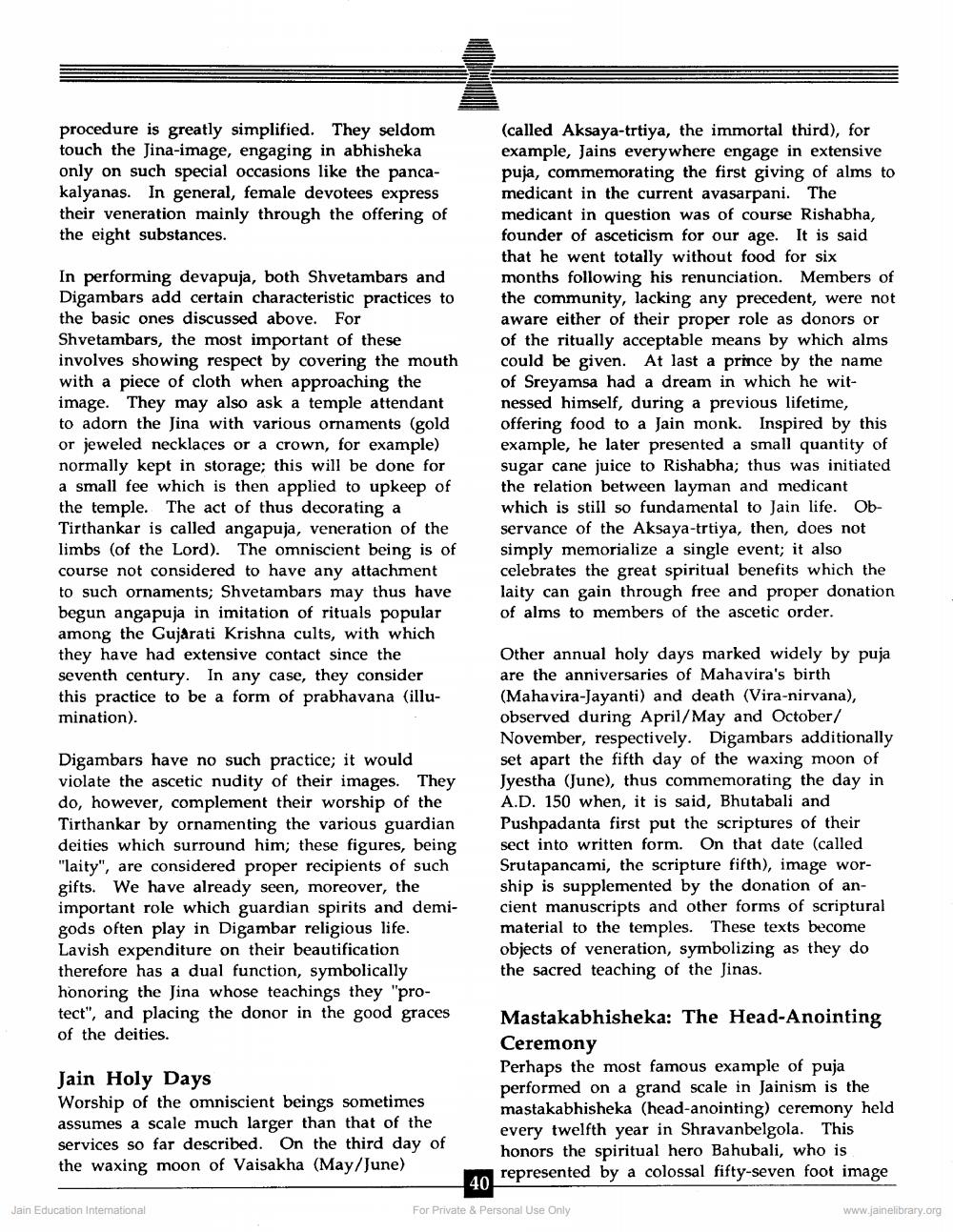________________
procedure is greatly simplified. They seldom touch the Jina-image, engaging in abhisheka only on such special occasions like the pancakalyanas. In general, female devotees express their veneration mainly through the offering of the eight substances.
In performing devapuja, both Shvetambars and Digambars add certain characteristic practices to the basic ones discussed above. For Shvetambars, the most important of these involves showing respect by covering the mouth with a piece of cloth when approaching the image. They may also ask a temple attendant to adorn the Jina with various ornaments (gold or jeweled necklaces or a crown, for example) normally kept in storage; this will be done for a small fee which is then applied to upkeep of the temple. The act of thus decorating a Tirthankar is called angapuja, veneration of the limbs (of the Lord). The omniscient being is of course not considered to have any attachment to such ornaments; Shvetambars may thus have begun angapuja in imitation of rituals popular among the Gujarati Krishna cults, with which they have had extensive contact since the seventh century. In any case, they consider this practice to be a form of prabhavana (illumination).
Digambars have no such practice; it would violate the ascetic nudity of their images. They do, however, complement their worship of the Tirthankar by ornamenting the various guardian deities which surround him; these figures, being "laity", are considered proper recipients of such gifts. We have already seen, moreover, the important role which guardian spirits and demigods often play in Digambar religious life. Lavish expenditure on their beautification therefore has a dual function, symbolically honoring the Jina whose teachings they "protect", and placing the donor in the good graces of the deities.
Jain Holy Days
Worship of the omniscient beings sometimes assumes a scale much larger than that of the services so far described. On the third day of the waxing moon of Vaisakha (May/June)
Jain Education Intemational
(called Aksaya-trtiya, the immortal third), for example, Jains everywhere engage in extensive puja, commemorating the first giving of alms to medicant in the current avasarpani. The medicant in question was of course Rishabha, founder of asceticism for our age. It is said that he went totally without food for six months following his renunciation. Members of the community, lacking any precedent, were not aware either of their proper role as donors or of the ritually acceptable means by which alms could be given. At last a prince by the name of Sreyamsa had a dream in which he witnessed himself, during a previous lifetime, offering food to a Jain monk. Inspired by this example, he later presented a small quantity of sugar cane juice to Rishabha; thus was initiated the relation between layman and medicant which is still so fundamental to Jain life. Observance of the Aksaya-trtiya, then, does not simply memorialize a single event; it also celebrates the great spiritual benefits which the laity can gain through free and proper donation of alms to members of the ascetic order.
Other annual holy days marked widely by puja are the anniversaries of Mahavira's birth (Mahavira-Jayanti) and death (Vira-nirvana), observed during April/May and October/ November, respectively. Digambars additionally set apart the fifth day of the waxing moon of Jyestha (June), thus commemorating the day in A.D. 150 when, it is said, Bhutabali and Pushpadanta first put the scriptures of their sect into written form. On that date (called Srutapancami, the scripture fifth), image worship is supplemented by the donation of ancient manuscripts and other forms of scriptural material to the temples. These texts become objects of veneration, symbolizing as they do. the sacred teaching of the Jinas.
Mastakabhisheka: The Head-Anointing Ceremony
Perhaps the most famous example of puja performed on a grand scale in Jainism is the mastakabhisheka (head-anointing) ceremony held every twelfth year in Shravanbelgola. This honors the spiritual hero Bahubali, who is represented by a colossal fifty-seven foot image
40
For Private & Personal Use Only
www.jainelibrary.org




